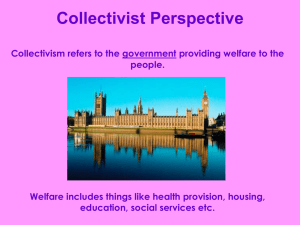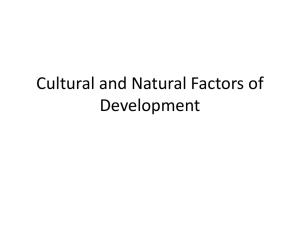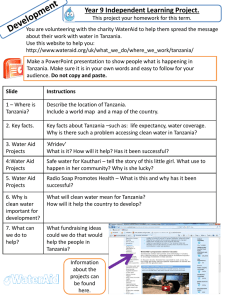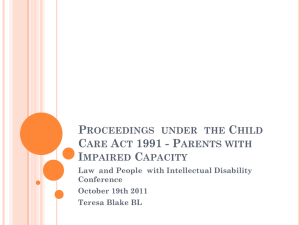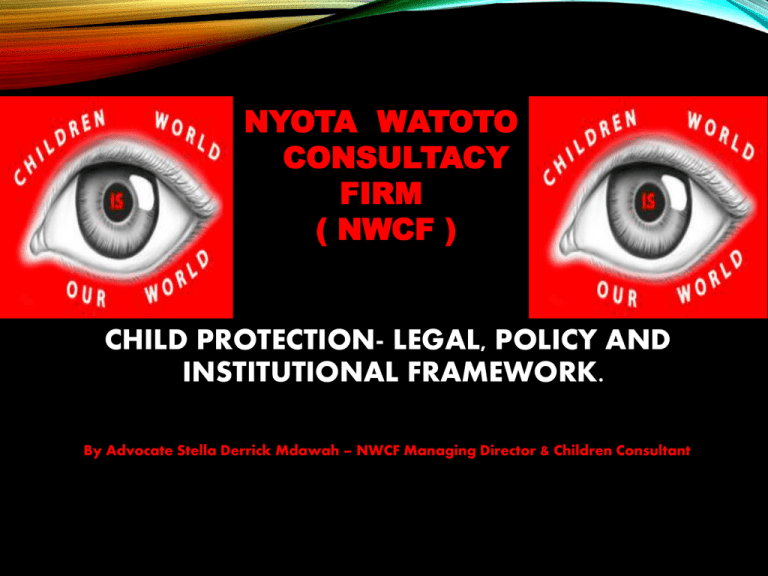
NYOTA WATOTO
CONSULTACY
FIRM
( NWCF )
CHILD PROTECTION- LEGAL, POLICY AND
INSTITUTIONAL FRAMEWORK.
By Advocate Stella Derrick Mdawah – NWCF Managing Director & Children Consultant
WHY THIS TRAINING MANUAL?
Introduction
• The aim of the training manual is to elaborate the
legal, policy and institutional framework protecting
children at the international and national level.
• Policies, regulations and guidelines as well as
structures are important for ensuring that children are
adequately protected.
CHILD PROTECTION AT
INTERNATIONAL LEVEL
Children enjoy protection by way of general human
rights provisions, and their relevance should not be
underestimated. For instance the Universal Declaration
of Human Rights, as the most prominent and
fundamental UN human rights document provides in its
Article 25 that childhood is entitled to special care and
assistance.
Furthermore, the UN International Covenant on Civil
and Political Rights, a legally binding document which
came into force in 1978, contains provisions specifically
referring to children.
CONTINUE......
• The Human Rights Committee (the body
responsible for monitoring the
implementation of the Covenant) has
emphasized that, the rights provided for in
Article 24 are not the only ones that the
Covenant recognizes for children and that,
as individuals, children benefit from all of
the civil rights enunciated in the
Covenant”.
CONTINUE.....
• The International Covenant /treaty/ agreement on
Economic, Social and Cultural Rights contains
several child-specific provisions, with a focus on the
right to education and protection from economic and
social exploitation.
THE UNIVERSAL DECLARATION OF
HUMAN RIGHTS
The declaration was adopted in 10th December
1948. It establishes the principles of freedom, peace
and equality to all man-kind. This was the first
children’s rights instrument adopted by the UN
General Assembly. These principles must be
observed by all member states more especially
through the respect of rule of law.
Rule of Law means Equality before the law(no one
is above the Law/ supremacy of the law/
predominance of the law.), Separation of power and
good governance
CONVENTION ON THE RIGHTS OF THE CHILD
(20TH NOVEMBER 1989)
This Convention consists of 54 Articles, incorporating the
full range of human rights –
civil, cultural, economic, political and social – and creates
the international foundation for the protection and
promotion of human rights and fundamental freedoms of
all persons under the age of 18. (minor/child).
The Convention represents widespread recognition that
children should be fully prepared to live an individual life
in society, and be raised in the spirit of peace, dignity,
tolerance, freedom, equality and solidarity.
CONTINUE.....
This convention is founded on the following principles, which build
the foundation for all children’s rights:
• The right to equality: No child may be discriminated against on the
basis of race, color, sex, language, religion, political or other opinion,
national or social origin, property, birth or other status.
• The best interest of the child 28 has to has to prevail: Whenever
decisions are being taken which have an impact on children, the best
interest of the child must be considered as A primary consideration.
CONTINUE......
The right to life and development: Every Member
State has to ensure, to the maximum extent possible,
the survival and development of the child by, inter
alia, providing access to health care and education,
and by protecting the child from economic and social
exploitation.
• Respect for children’s own views: Children should
be respected and taken seriously, and they should be
involved in decision-making processes according to
their age and maturity.
The CRC follows a holistic approach to children’s
rights, recognizing that the rights anchored/ protected
in the Convention are indivisible and interrelated, and
that equal importance must be attached to each and
every right contained therein.
•
CONTINUE.....
Some of the rights under the CRC relate to family
environment and alternative care, covering the
Convention’s Articles 5, 9–11, 18(1) and (2), 19–
21, 25, 27(4) and 39. This cluster addresses the
fields of parental guidance; parental
responsibilities; separation from parents; family
reunification; recovery of maintenance for the
child; children deprived of a family environment;
adoption; illicit transfer and non-return; and abuse
and neglect including physical and psychological
recovery and social reintegration.
CONTINUE....
• Likewise, there is a group of rights that contain special
protection measures as laid down in Articles 22, 30, 32–36,
37(b)–(d), 38, 39 and 40. Special protection measures are
provided for, among others, children in situations of
emergency; refugee children; children in armed conflicts,
including physical and psychological recovery and social
reintegration; children in conflict with the law with regard to
the administration of juvenile justice; children deprived of their
liberty, including any form of detention, imprisonment or
placement in custodial settings; children in situations of
exploitation, including child labour; and children belonging to
minority or indigenous groups.
• It requires all member states to take measures aiming at
combating abuse, neglect and exploitation of children
OPTIONAL PROTOCOL TO THE CONVENTION ON
THE RIGHTS OF THE CHILD ON THE SALE OF
CHILDREN, CHILD PROSTITUTION AND CHILD
PORNOGRAPHY
• The protocol ensure that provisions protecting
children from economic exploitation and from
performing any work that is likely to be hazardous
or to interfere with the child's education, or to be
harmful to the child's health or physical, mental,
spiritual, moral or social development are adequately
addressed.
CONTINUE....
In furtherance of the Convention on the Rights of the Child and
the implementation of its provisions, especially articles 1, 11, 21,
32, 33, 34, 35 and 36, the optional protocol extends measures that
states need to take in order to guarantee the protection of the child
from the sale of children, child prostitution and child pornography;
international traffic in children for the purpose of the sale of
children, child prostitution and child pornography; practice of sex
tourism, to which children are especially vulnerable; vulnerable
groups, including girl children, are at greater risk of sexual
exploitation and that girl children are disproportionately
represented among the sexually exploited
CONTINUE...
The protocol emphasizes that the elimination of the sale of
children, child prostitution and child pornography will be
facilitated by adopting a holistic approach, addressing the
contributing factors, including underdevelopment, poverty,
economic disparities/ equalities, inequitable socio-economic
structure, lack of education, urban-rural migration, gender
discrimination, irresponsible adult sexual behaviour, harmful
traditional practices, armed conflicts and trafficking in children. it
highlights the importance of raising public awareness are in
reducing consumer demand for the sale of children, child
prostitution and child pornography.
CONTINUE...
• This is an important addition to the CRC in that it is
aimed at specifically protecting children from
entering into armed conflict or participating in
armed hostilities. It lays emphasis on the role of the
state in taking measures that will ensure that
children are not recruited into the army. The protocol
provides for a minimum age into entry into armed
forces to be 18 years. It reinforces the need to
protect all children from armed conflict.
AFRICAN CHARTER ON THE RIGHTS AND
WELFARE OF THE CHILD
• The Charter aims to complement/ balance the CRC
and additionally addresses issues of particular
importance to children in Africa. The Charter was
adopted in view of the critical situation in which
most African children find themselves in terms of
their socioeconomic, cultural, traditional and
developmental circumstances, natural disasters,
armed conflicts, exploitation and hunger
CONTINUE...
• The Charter points out that child require particular
care and legal protection, and that they deserve
freedom, dignity and security due to their physical and
mental development. Thus, the Charter, clearly and
without limitation, defines a child as any person under
the age of 18, it completely outlaws the recruitment
and use of child soldiers, it sets the minimum age for
marriage at the age of 18; and it includes internally
displaced children with regard to the protection of
child refugees. In this sense the African Charter goes
further than the CRC.
ILO CONVENTIONS ON CHILD
LABOUR
• Convention on the Worst Forms of Child Labour
182 of 1999 and the Convention on Minimum
Age of Employment 138 of 1973 define a child
to be a person under the age of 18 years.
• Convention 138 contains child-protective
provisions. For example, it encourages States
Parties to specify a minimum age for
employment, and it emphasizes that the interests
of children are paramount.
CONVENTION ON ELIMINATION OF ALL
FORMS OF DISCRIMINATION AGAINST
WOMEN
Convention on Elimination of All forms of Discrimination Against
women addresses issues of violence and discrimination facing
women and girl children and calls for the absolute elimination of
all conditions that put women and children at risk from abuse and
violence.
Worst forms of child labour are categorized into two groups, the
unconditional worst forms, these are the types of child labour that
cannot under any circumstance be tolerated, for example child
prostitution, recruitment of children in armed conflict, engaging
children in illicit activities (e.g. sale of drugs) and forced labour
UN GUIDELINES FOR THE APPROPRIATE USE AND
CONDITIONS OF ALTERNATIVE CARE OF
CHILDREN
The guideline highlights the importance of a child
growing up in a family. The family is the core and
central unit for caring for a child. It emphasizes that
all efforts should be made to ensure that children
remain in or return to the care of their parents and if
not possible, then close family members.
The responsibility of the state is to ensure that
families are capacitated to provide care. It provides
conditions for alternative care
The child should be as close as possible to the
habitual place of residence for ease of contact and
potential re integration with family
CONTINUE...
The home must be stable and ensure that the child gets
the basic needs, safety and continuous attachment to the
caregivers
Children should be treated with dignity and respect and
must not under any circumstances be abused in any way
Removing children from their family should be seen as
a measure of last resort and poverty should not be a
sufficient ground for removal of a child from their
homes. Removal should also be in the best interest of
the child.
CHILD PROTECTION AT NATIONAL
LEVEL
National Policy and Legal Framework.
The Legal Framework
The Constitution of the United Republic of Tanzania
• The constitution of the United Republic of Tanzania upholds
principles of human rights and justice. The Constitution
provides for the age of a child to be under 18 years and for all
citizens of Tanzania to be guaranteed basic rights, including
children. it prohibits discrimination based on gender, age,
race and ethnicity
THE LAW OF THE CHILD ACT (2009)
• It is important to remember that international treaties do not
become law in Tanzania unless they have been ratified /
approved by the Parliament and domesticated into national law.
• Most of these laws have been domesticated. The current Law
of the Child Act reflects key principles outlined in international
instruments, particularly the CRC; the SOSPA (Sexual Offences
Provision Act) outlines principles stated in the CEDAW.
• This is a new law that safeguards and ensures the protection
and welfare of the children. The Act lays down the definition of
the child to be a person under 18 years of age
CONTINUE...
• This automatically forces other statutes dealing with
children to conform to this new Act since is
considered to be the Parent Act dealing with
children’s rights. Provisions of the Act are based on
the principle of the best interests of the child as
emphasized by the CRC. However, the LCA goes
further than the CRC, stating that the best interests
of the child is THE primary consideration in all
actions concerning a child whether undertaken by
public or private social welfare institutions, courts or
administrative bodies.
CONTINUE...
The Act covers the right not to be discriminated, the
right to a name and nationality and the right to grow
up with parents. Other rights provided for in the Act
include the right to life, the right to dignity, the right
to be respected, the right to leisure, the right to
liberty, the right to health, the right to education and
the right to shelter to be provided by his parents. It
also provides safeguards and protection of the child
from entering into discotheques, bars and night
clubs. Also the roles of Social Welfare Officers are
outlined, in relation to care and protection and in
respect of children in contact and in conflict with
the law.
CONTINUE......
The Key Policies
Since mid 1990’s, Tanzania has developed national and
sectoral policies to promote the welfare of children.
Tanzania has also ratified most major international
human rights instruments on children. These include the
UN Convention on the Rights of Child(CRC) which was
ratified on 10th July, 1991,(include the 2 optional
protocols) the African Charter on the Rights and Welfare
of Children(ACRWC) which was ratified on 9th May 2003
and the UN Convention on the Elimination of All forms of
Discrimination Against Women(CEDAW) which was
ratified on 21st August 1985.
CHILD PROTECTION POLICY
• While some policies are specifically child focused like
the Child development and the Education and Training
policies, there others which are of a more general
nature like the Health policy, Food and Nutrition and
Community Development policies although they are
addressing issues that are of major importance to
children.
CONTINUE...
When considering policy, it is important to bear in
mind that children’s issues are broad and interlinked
and therefore important to identify all policies that
have a bearing on children’s health and welfare.
It should be noted that, the realization and enjoyment
of children’s rights entail fulfilment of all rights ,
which are provided for in the Convention on the
Rights of the Child (CRC) and the African Charter on
the Rights and Welfare of the Child. These rights are
normally categorized into four basic Rights clusters. ;
Right to Development, Right to Protection, Right
to Participation and Right to Survival.
CHILD DEVELOPMENT POLICY, 2008
The policy aims at promoting child survival,
development, participation and life. A child is defined as
a person below the age of eighteen years. It highlights
the need to protect children living in difficult
circumstances, such as orphans, children with
disabilities, street children, children affected by natural
disasters.
The Ministry concerning gender and children has a
five year strategic plan (2006-2011) which among
other things, aims at promoting and protecting rights
of children, women and men as well as achieving
quality and equity.
EDUCATION AND TRAINING POLICY, 1995
• One of the aims is to enable children out of formal
school system to improve the quality of their life
through a variety of relevant educational and training
programmes.
• Policy states that Government shall promote,
strengthen, coordinate and integrate non formal
education with formal education and training systems.
The Education Act of Tanzania provides for the
development of the system of Education based on the
national policy on education and other national plans
and priorities.
CONTINUE...
The act provides that every citizen of the United
Republic of Tanzania is entitled to receive the level of
education as his ability may permit him/her. In case a
parent fails to enroll his/her child to primary school
commits an offence.
The Primary School (Compulsory Enrolment and
Attendance) Rules provides for measures to be taken
in case a parent fails to enroll his child or when a
parent or any other persons in any circumstances
cause a child to not attend school.
NATIONAL ACTION PLAN ON MOST
VULNERABLE CHILDREN (MVC) 2007 2011
• The MVC is a breakthrough document that highlight
government’s plan of reaching the MVC. It contains
details in numbers per region of the MVCs and how
they will be supported.
• The plan focuses on six main areas being, policy
and service delivery environment, household and
child level care, protection and security,
psychosocial support, measuring the process and
resource mobilization.
NATIONAL EMPLOYMENT POLICY AND EMPLOYMENT AND LABOUR
RELATIONS ACT, 2004
Ministry of Labour, employment and youth development
coordinates the Labour policy, national employment policy,
trade unions, human, informal sector, youth development
policy, employment and youth self-reliance projects,
vocational training youth organizations, probation and
repatriation of destitute youths. they are also in charge of the
national strategy on child labour. the employment and labour
relations act, 2004 provides for protection of the child against
labour exploitation (section 5). the act stipulates that no
person shall employ a child under the age of fourteen years.
NATIONAL MULTISECTORAL SOCIAL
PROTECTION FRAMEWORK
The National Multisectoral Social Protection Framework
(draft 2008) is the overall national strategy for addressing
the development needs of those who are generally
considered poor or at risk from falling into poverty as well
as those who live in extreme levels of poverty.
The framework has outlined specific extremely
vulnerable groups as a target for support. Strategies to be
used in addressing the social protection needs of children
include scaling up of successful state and non state actors
community based care and support programmes for MVC;
increased access to social services, vocational training,
and grants/financial support (e.g. cash transfer, child
grants, social scheme)
NATIONAL POVERTY REDUCTION STRATEGY PAPER
(MKUKUTA)
MKUKUTA Cluster II focuses on achieving two
broad outcomes, namely: (i) improved quality of life
and social wellbeing, particularly of the poorest and
most vulnerable groups (MVC) in the population; and
(ii) reduced inequalities (e.g., in education, survival,
and health) across geographic areas, income, age,
gender and other categories.
MKUKUTA II focus focuses on how to deliver
quality social services (education, survival, health and
nutrition, clean and safe water, sanitation, decent
shelter and a safe and sustainable environment) for the
poor and most vulnerable
CONTINUE.....
• Goal 6 aims at providing adequate social protection
and rights to the vulnerable and needy groups. in
meeting the goal, MKUKUTA will focus on social
protection interventions for orphans and vulnerable
children; people with disabilities; the elderly; people
living with HIV and long term illnesses; vulnerable
women and youth; former inmates and people disabled
by accidents, wars and conflicts
CHILD PROTECTION -INSTITUTIONAL
FRAMEWORK/SUPPORT
• There are several institutions responsible for children’s
rights and welfare in Tanzania. This unit elaborates on
the structures from national levels to community
levels. Each of the structures has a specific role in
terms of protecting children, however they are
interdependent.
MINISTRY OF HEALTH AND SOCIAL WELFARE
CHILDREN’S HOMES, REMAND HOMES,
APPROVED SCHOOL, DROP IN CENTERS
The Department of Social Welfare, which was
established in 1967, is a department within the
Ministry of Health and Social Welfare. Its primary
function is to lead and coordinate the efforts of the
government to provide for the social welfare needs of
the most vulnerable and marginalized populations.
The government has specific institutions that aim at
protecting children. Institutions under the governance
of the Ministry of Health and Social Welfare,
particularly the department of social Welfare include
the following:
CONTINUE...
Day Care Centre's
In Tanzania, child care services are provided through two
structures - Day Care Centre's and Children’s Homes. The
former prepare children aged 2-6 for primary education, and
are registered and monitored by the Commissioner of Social
Welfare who is responsible for establishing standards and
monitoring performance.
Children’s Homes
Children’s Homes are established by Law of the Child Act.
Under the law Section 2 “Children home” means any premises
other than an approved school, where five or more children
being orphans or children whose relatives or guardians are
unable or unwilling to care for them are received to be cared
for and maintained, either gratuitously or for payment, for a
period of longer than seven days by a person who is not a
relative or guardian of the children.
CONTINUE..
Remand homes
On the mainland of Tanzania there are only five remand
homes which have a capacity of 215 children at a time.
Because of low capacity, children often end up in police
lock-up or in remand with adults despite legal
requirements that they should be separate premises.
Approved School/ the correction centre
provide reformative and reintegration programmes to
prepare for reintegrate into society when discharged.
They provide counseling, life skills and vocational
training.
MINISTRY OF COMMUNITY DEVELOPMENT, GENDER
AND CHILDREN
The ministry responsible for overall policy on children in Tanzania is
the Ministry of Community Development, Gender and Children.
The main distinguishing factor between this Ministry (department of
children) and the Department of social Welfare is the fact that this
Ministry is vested with the mandate to address issues affecting
children in general while the department of Social Welfare is vested
with the mandate to focus on vulnerable children or children
vulnerable to abuse, exploitation and neglect.
The Ministry of Community Development, Gender and Children has
formed a Task Force to address issues of violence against women and
children.
MINISTRY OF EDUCATION AND VOCATIONAL
TRAINING
• The Ministry of Education has the responsibility of
coordinating, reviewing and recommending strategies
on basic education
• The government is also expanding vocational schools
to reach every district in order to absorb children who
are missed out in the enrolment for secondary
education; implementation of this plan is yet to
materialize / happen.
THE JUDICIARY
The Judiciary is the body in Tanzania that is mandated to adjudicate
cases and administer law. It is established from central to lower
levels of governance. The Court of Appeal is the top appellate court,
the High court is a court of appeal for matters emanating from lower
courts, but it is also a court of first instance when an issues requires
the audience of High Court judges.
Many of the cases involving children are dealt with by Magistrates
Courts or Primary Courts. These are district based courts, the
Magistrate and District courts are based at the district level while
Primary Courts are based in villages. At village levels, there are also
tribunals mandated to deal with specific issues, such as land. These
are not mandated to deal with child abuse or neglect.
CONTINUE...
• There is only one Juvenile Court in Tanzania.
However, this court is based in Dar es salaam and
therefore cannot hear all cases involving Juveniles
occurring in all parts of the country.
• The Law of the Child Act allows the Chief Justice to
designate any premises used by a primary court to be a
Juvenile Court. This is why such cases are heard by
Magistrates/Primary Courts, but in an environment
that provides juveniles with the same rights and
conditions.
MINISTRY OF HOME AFFAIRS - THE POLICE
• The Tanzania Police Force has formed Tanzania Police
Female Network on violence against women and
children. The police is an important department in
ensuring that children are protected, particularly
children that come in contact with the law. The police
are located in all districts in Tanzania, but they are not
located in all villages.
• Currently, in some of the police stations, there gender
desks whose main function is to hear cases brought in
by women and children or cases.
COMMISSION FOR HUMAN RIGHTS AND GOOD
GOVERNANCE (FORMAL)
The Commission for Human Rights and Good Governance is
responsible for monitoring human rights issues including rights
of children.
The Commission has a children’s desk that deals with
children’s rights.
The commission has procedures for conducting research,
public hearings, complaint handling procedures and other
processes that aim at ensuring that rights of citizens in Tanzania
are realized and protected. One of the function of the
commission is to promote within the country the protection and
the preservation of human rights and of duties to the society in
accordance with the Constitution and the laws of the land; In
line with that, the commission has established a directorate of
children to ensure that children issues are being sensitively
dealt with.
DISTRICT AND COMMUNITY BASED STRUCTURES
Local Level Committees:
• There a number of committees at district, ward and village levels.
The main role of these committees is to protect children and therefore
it is important to link all work aiming at protecting children to these
structures. Some of these structures have been formalized and others
are not formalized. The child protection structures have just been
established through an informal but integrated process involving all
the key departments dealing with children at district levels. Child
Protection Structures have been established in a few districts in
Tanzania and therefore are not operational countrywide.
DISTRICT CHILD PROTECTION UNIT
(INFORMAL)
The child protection unit is based at the district level
and its main role is to monitor, supervise and guide all
work concerning abused children.
The Unit is made up of different actors from different
departments at district level (mainly community
development, social welfare and any other) working
together to address child abuse and exploitation.
The Unit is supported by a Child Protection Team that
is broader and multisectoral. The team meets once
every quarter to discuss progress on various issues
regarding child protection.
CHILD LABOUR COMMITTEES (INFORMAL)
• These are committees that are established to monitor
child labour in districts and villages. Most of them are
usually district based, but in some of the districts, they
have child labour committees at village level.
• The level of implementation of this committees is at
the District/Ward/Village
MVCC (INFORMAL)
• At the community level, MVC committees have been
established; these committees follow up on various
activities aimed at protecting vulnerable children.
They are also responsible for compiling data on MVC,
advocating for the rights of children, preparing plans
and budgets and links with schools to enhance access
to education for MVC and link them to health
facilities.
• The level of implementation of this committees is at
the Village
VOLUNTEERS/PARA SOCIAL WORKERS
(INFORMAL)
These are people that work on specific issues at
village level. While some of them may be recognized
by government structures (paid salaries) others are
merely volunteer that work on issues concerning
children.
They often work in collaboration with community
based structures and village government. they have
no mandate to make decisions concerning welfare of
children in general but can provide opinion. Their
main role is often to provide a service or move a
service closer to the community.
The level of implementation of this committees is at
the Village
CHILD PROTECTION IS
RESPONSIBILITY OF EVERYONE
MERCI / THANK YOU
“Together we bring hope and
make the world a better place for
children.”


